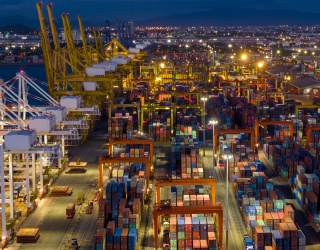
Many digital tools presented at EuroCIS over the past few years, have become indispensable to retail today. Which in-store media asserted themselves and what is so special about them? And, beyond this, which tools and technologies have great potential for the future? Taking a close look at the POS as well as at the forthcoming EuroCIS, held in Düsseldorf from 19 to 21 February, shows us that exciting innovations ahead are guaranteed.
In just a few years Digital Signage has become a standard feature in retail. Monitors with atmospheric stills, videos, news and advertising have long found a place in small companies, too, forming part and parcel of today’s modern customer communication. Be it in shop windows or in-store, as an in-store stele, an LED wall behind the check-out, extended electronic price-tag or as a digital guidance system. And we are only at the beginning of this development. dimedis, for example, has discovered the weighing scales in the fresh food area of food retail stores as a new tool to make shoppers an offer. At EuroCIS the Cologne-based company will present their digital signage software integrated with Mettler Toledo weighing scales for the first time.
“In any case the solution that allows us to stream content on various terminal devices at the outlet will be one of our EuroCIS highlights,” announces Patrick Schröder, head of BU Digital Signage at dimedis, and goes on to report: “Interfaces with databases such as management information systems are becoming increasingly relevant and make digital signage even more dynamic.” For instance: thanks to WWS connection, products are only promoted on the screens as long as they are actually in stock. As soon as the items are out of stock, the promotion via this media is automatically stopped. Supplier Bütema from Bietigheim-Bissingen has developed its systems further to cover another area: “We move emotions centre stage and incorporate both light and acoustics so as to appeal even more strongly to all the senses,” says Head of Marketing Stefan Schiek shedding light on Bütema’s trade fair appearance.
Mobile first!
The latest hottest trends: making systems interactive, integrating touch and increasingly also speech functions and integrating smartphones. Retail staff can adapt digital-signage content via smartphone to a changed goods display while consumers can interact with specific content. “Since most shoppers are ‘always on’ and increasingly ‘mobile only’, the smartphone is becoming the decisive touchpoint,” remarks Dr. Gerd Wolfram, General Manager of consultancy IoT Innovation & Consult and co-author of the book “Digital Connection” published recently. Martin Heinzmann, COO of fashion store Hagemeyer headquartered in Minden, confirms: “Before we invest in digital devices today we ask ourselves – why would a shopper use our device instead of their own smartphone?”
In Dr. Gerd Wolfram’s experience, digital in-store solutions require two properties to become a highlight: they must be easy to operate and place the customer journey centre stage. “Only then will they be accepted and deliver added value.” The former Project Manager of the Metro Group Future Store Initiative makes it even clearer: “In-store technologies will assert themselves if they provide shoppers with more detailed and comprehensive product information than analogue labels/signs can. Worth mentioning here are product finders, virtual promoters or Virtual Reality applications. Also helpful are solutions that show whether articles are in stock or whether comparable or complementary items are available. Let’s not forget styling assistants, smart dressing cubicles or smart shoe mirrors. But I’m also thinking of value-added services here such as foot scanners at shoe shops to measure foot size, or kiosk systems that support quick home delivery and product tracking. Other meaningful services include modern, mobile phone-based payment methods.” And here we come full circle again – the smartphone as the hinge point: this also makes clear how wide the spectrum of digital tools already is for physical retail today. Purely analogue: hard to imagine!
Retail “goes App”
Swiss company Scandit also offers flexible payment solutions by tablet (via mobile check-out staff/sales assistants) or by smartphone (consumers’ self-checkout). Integrated into a mobile App, Scandit’s Barcode Scanner SDK converts mobile devices into quick and reliable barcode scanners. Such devices score points not only for self check-out but also for assisting shoppers. The digitally enhanced interaction with the physical store environment, including advanced data collection and AR solutions, gives shoppers access to product information and availability, personalised bargains and other useful content. “We think optical image and content recognition (OCS) as well as Augmented Reality (AR) hold great potential for the future,” says Ulrich Hieber, Sales Director Deutschland at Scandit, and adds: “By gearing up mobile devices such as smartphones, tablets and wearables with these modern Apps we can create an omnichannel store environment that can compete with e-commerce.” An example here: shoppers or sales assistants direct their smartphone camera to a host of products on the shelf and will have all vegan products displayed in green. For sales assistants the AR-enabled Apps provide product information that makes processes such as price checks, picking and inventories management far more efficient.
Everywhere and across various segments, retailers are currently providing their staff with digital assistants in the retail space. Another trend theme is staff Apps which make for interactive internal communication in real time. Managers and department heads can furnish their sales teams with news and can also receive their feedback and questions in return. A special event organised in the womenswear department, for example, can be just as interesting for all other departments. For one thing, to cash in on cross-selling opportunities, and for another, to be well informed for shoppers’ enquiries. There are more and more specific Apps for sales staff available now. “In shoe retail nobody has to physically check inventories any longer to know whether the desired style is in stock. A glance at a smartphone or tablet suffices. Furthermore, staff know whether Click & Collect merchandise was received and where it is,” explains Stefan Schiek referring to the Bütema-App “sovia Instore Assistant”. Endless-shelf modules for repeat orders from suppliers are now also connected more and more often. A new study carried out by DHBW Heilbronn confirms that endless-shelf systems hold great potential for boosting sales in offline retail.
Utility before Entertainment
Speaking of studies: the standardisation organisation GS1 Germany and market research institute GfK have just researched “shoppers’ perception of digital POS measures”. The results are unambiguous: for shoppers time savings and utility rank higher than applications that only serve entertainment purposes. A case in point are the humanoid robots that were among the most attention-grabbing highlights at the last EuroCIS. The “cute little guys” can now be found at electronics and specialist fashion stores. They welcome shoppers and entertain them with dancing, gaming and fun. They shake hands, tell jokes, pose for selfies and guide shoppers through the stores. The “novelty factor” is still high but considering our fast-paced world today this effect will probably “wear off” over time. This is why these robots will only be used in isolated cases as marketing-only tools. In contrast to this, they stand very good chances long term in logistics, warehousing and for the automation of processes in general. The vertical fashion operation Zara, for example, has recently installed a fully automated Click & Collect department. Consumers who come to collect goods ordered online simply scan the QR code of their order. A robot system then makes the packages available for pick up. “The store of the future will link digital and physical retail experiences in such a way that customer satisfaction and loyalty are increased while operations are rationalised at the same time,” says Ulrich Hieber summing up the trend. EuroCIS will see another big step taken in this direction.









